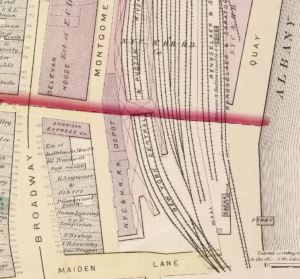
Amtrak knows you have choices in rail travel and appreciates … oh, wait, no you don’t. If you want to travel by rail in this country in 2015, other than commuter rail, you’ve got precisely one option. In 1863 Albany, things were very different.
Remember that the Livingston Avenue Bridge, the first bridge across the Hudson at Albany, didn’t open until 1866. Before that, travelers had to get to one side of the river or the other, by ferry, to get to the railroad of their choice. (Alternatively, they could ride up to Troy and cross the river there.) But choices there were. Some of these specialized in freight, of course.
One thing worth noting, though – in certain circles there is frequent carping that the train station should never have left Albany and been moved to Rensselaer. The reality is that trains were leaving from Rensselaer, in far greater numbers than they left from Albany, long before the fondly remembered Union Station was even built.
On the Albany side, the rail options were:
Albany and Susquehanna Railroad Nearly complete in 1863, it ran from Albany to Binghamton. The office was at 73 State Street. Ezra Prentice was the President; today his name is mostly remembered with a Albany Housing Authority complex on the south end, but he held a number of political posts in the 19th century, including President of the New York State Agricultural Society. Would you like to read some poems written about the Albany and Susquehanna? Of course you would. It was absorbed into the Delaware and Hudson in 1945.
Albany and Vermont Railroad The Albany and Vermont was a successor to the Albany, Vermont, and Canada, which was a successor to The Albany Northern Railroad Company. Its board included Erastus Corning and Lansing Pruyn. It ran from Albany through Cohoes to Waterford and then to Eagle Bridge in Washington County. It’s not clear that it ever actually reached the Green Mountain State; an 1880 article on its sale to interests in Troy noted that it ended at Eagle Bridge. It was leased and actually operated by the Rensselaer and Saratoga Railroad company, and trains left from the New York Central depot which, as noted on the map, was on Montgomery Street, east of Broadway, just north of Maiden Lane. (Montgomery Street still exists, but only as alleys/sidewalks behind the buildings facing Broadway.) Its president was Thomas W. Lockwood.
Albany and West Troy Horse Railroad This one was led by A.A. Dunlop, President and Treasurer, and Peter Hogan, Secretary and Engineer. West Troy at the time was what is now Watervliet (and Watervliet at the time was what is now the town of Colonie). When construction of this road was awarded in 1862, it was announced that it would run from the South Ferry in Albany, up Broadway, thence on the Troy road to the north of the village of West Troy. It was double-tracked most of its distance.
New York Central Railroad The big kahuna. Its general offices were in the Exchange Building, and the location of the depot is shown on the map above. An 1879 map of the NY Central and Hudson River Railroad can be found here, but it’s a bit confusing as it shows the line passing through East Albany, not Albany; that would seem to only reflect the Hudson River Railroad’s route.
The rest of these railroads, even the ones with “Albany” in their names, departed from a depot in East Albany, which was a part of what later became Rensselaer:
Albany and West Stockbridge Railroad Dating to 1836, this one left from Greenbush, went south through Schodack Depot on a path of tracks that I believe still exists, through Niverville to Chatham and then turned west toward Massachusetts. In 1863 it was listed as leased and operated by the Albany and Boston Railroad, and its directors were some of the grand Albany names: Thomas W. Olcott, John V.L. Pruyn, Chester W. Chapin, Volkert P. Douw, and others.
Harlem Railroad This one had an office in Maiden lane at the corner of Dean street, but trains left from the depot in East Albany. It proceeded on the Albany and West Stockbridge tracks to Chatham Four Corners, and then continued south to New York City.
Housatonic Railroad This one also left from the depot in East Albany. How it connected with the Albany and Boston and the Albany and West Stockbridge is for better minds for minutiae than mine, and it ended … well, somewhere in Connecticut. You go figure it out.
Hudson River Railroad This railroad also had an office at Maiden and Dean, but left from East Albany and traveled south to New York City. Smith Briggs was its general agent, and Robert G. Cruttenden its ticket agent. In 1863, it was just about to come under the control of Cornelius Vanderbilt, and it would be merged with the New York Central in 1869.
Troy and Greenbush Railroad This ran from East Albany / Greenbush north to Troy, and would become a part of the Hudson River Railroad.

Leave a Reply